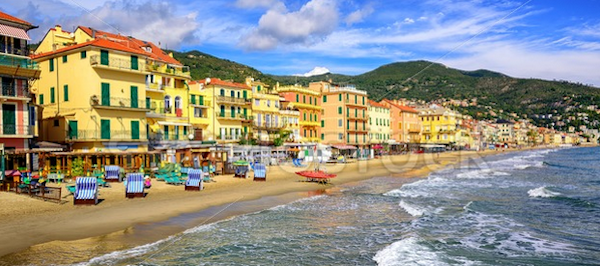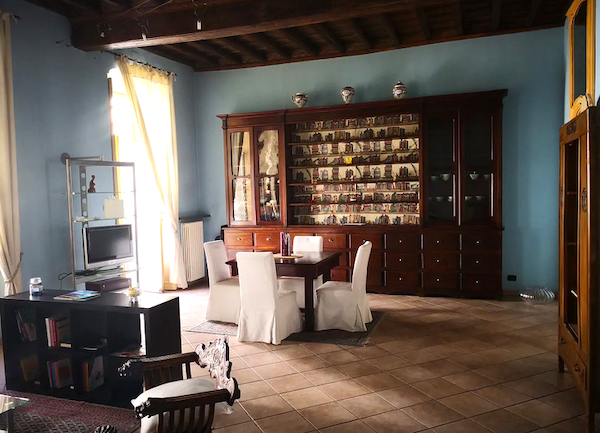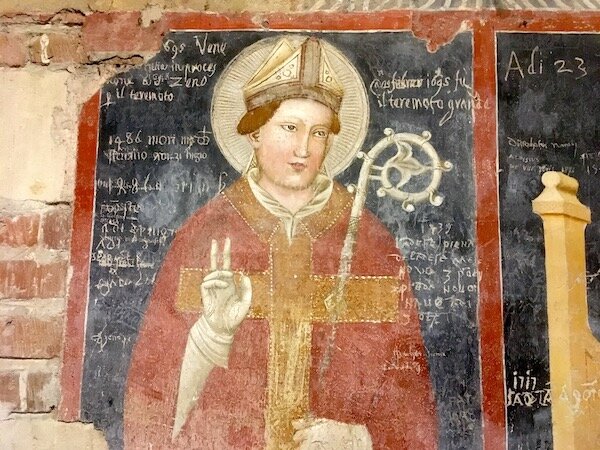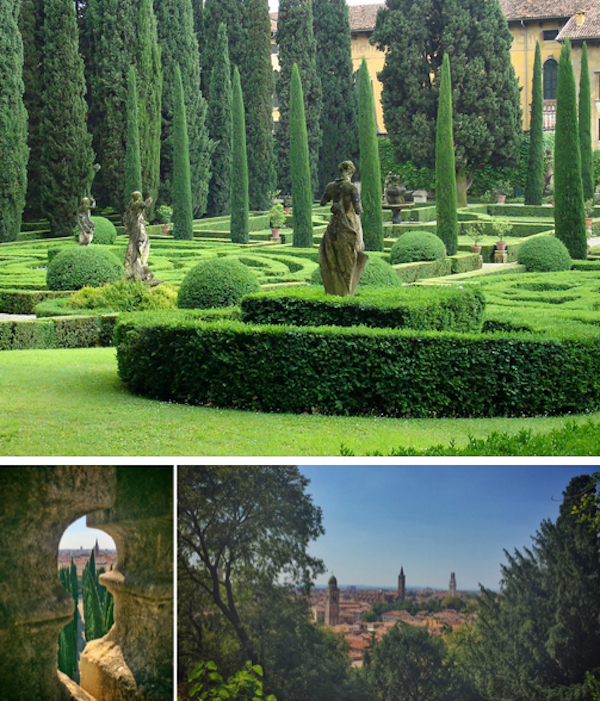Sunny Sanremo, Italy
Thirty-one years ago, when we were living in London, our dear friends the Picha’s came to visit and our Goddaughter Allie Picha was baptized alongside our son Christopher in Wolvercote near Oxford, England. Perhaps it was during that visit, even though she was just a baby, that Allie first fell in love with England.
Because all these years later, she is returning to England with her fiancé Gabe to be married in the Cotswolds on Thanksgiving Day. Since we were still in Europe when we got the invitation we’ve delayed our usual fall migration home to Seattle to be there on the big day.
This post starts at the beginning of October when we were in Paris with family in Samois. It was starting to get chilly, and we needed to chill out for a while - so we decided to return to the warmth of the Mediterranean where we’d spent time in Portugal, Spain, and France over the summer.
This time we headed to Italy, a country we’ve explored from top to bottom and side to side but never tire of. Michael’s itinerary would get us to the coast, but also to some new places along with some old favorites.
One of Michael’s many maps. This lays out our itinerary from October 7th - November 22th when we leave Malta for the UK. for Allie Picha’s wedding.
To break up the journey from Paris to Sanremo, our first coastal destination, we stopped for a few days in Turin. Torino (as it’s pronounced in Italian) was for years the automobile manufacturing hub of Italy, but most of those factories including Fiat have closed or moved south where labor is cheaper. The city slumped for a while, but it has set its sights on tourism. It has a way to go before it catches up with the rest of Italy’s top destinations, but there is a lot to see in this elegant, historically significant city.
For one thing, it’s an architectural buff's dream city. On our walking tour, we found roman ruins, stately palaces, Gothic churches, Fascist monoliths, and dozens of flowery Art Nouveau mansions staring down their streamlined rationalist counterparts.
Turin is a dream destination if you love architecture. I was in heaven because I am a big fan of brick buildings and there were some magnificent examples of what a humble piece of clay can do. The pharmacy in the upper left was just across from our Airbnb and I filled a prescription there. The inside is as ornate as the outside!
A perfect example of a classic, arrow straight Roman road and the many arched walkways alongside.
Michael was especially intrigued with the city’s almost perfect grid layout - a legacy from the Romans, and the extensive archways that kept us under cover throughout much of the city. The tour ended at the base of the Mole Antonelliana, also known as “The Mole”, Torino’s major landmark. It was begun in 1863 as a synagog, but the project went well over budget and was sold to the city before it was completed. It is now a popular cinema museum and has an observation deck at the top. Its silhouette has become the symbol of the city, and each year there is a contest to select the best tower illustration. The winner becomes the tourism symbol for the following year.
The Mole! The symbol of Turin and a pretty stunning landmark.
We spent an entire morning exploring Palazzo Porto, Europes largest outdoor market. It was an exotic potpourri of fresh produce, fish, poultry, every kind of meat, mountains of cheese, cheap clothing, housewares and anything else you may, or may not need.
Next door there is a newly built “food hall” called Mercato Centrale where the city's trendiest restaurants have enclaves. Turin is also Europe’s chocolate capital. And in one of the many coffee houses, you can get your lips on a Bicerin, Turin’s renowned layered espresso, chocolate, and cream concoction. If you want to drink like a local you will resist the urge to stir. Here is the recipe courtesy of chocolate fanatic David Lebovitz.
Our Airbnb was also a treat. We were on the second floor of a stately 18th-century building that opened onto a half-mile long pedestrian shopping street. We could lean out of our large windows and watch tourists and locals alike strolling by (most often with a cone of gelato in hand) or sitting at cafes. And one afternoon an energetic protest march against low and unpaid wages rumbled past.
Our Airbnb featured 15-foot ceilings, stained glass doors, original moldings and beams hand-painted with floral patterns that are still vibrant 265 years later.
Our Airbnb host Antonella was great. We enjoyed a warm evening together sitting outdoors for “Apertivo” - an Italian Happy Hour tradition where nibbles are offered for free or almost free along with your drinks. Every bar does it differently, so it can be as simple as chips and olives and a variety of bruschetta, or as elaborate as a buffet of hot and cold appetizers that could easily count as dinner.
Sanremo harbor. This unassuming fishing village belies its Italian Riviera location.
After six days we were ready to head to Sanremo. Most of our travel in Italy would be by train, but this time we took a Flixbus, We’ve been so happy with this budget bus service we use it whenever we can.
It was a very scenic, winding journey over mountains dusted with early snow, and then swooping downhill to sea level. Our host Daria, a vivacious, and very beautiful Russian woman was at the bus station to meet us. She is also strong! She lifted our suitcases like they were nothing more than heavy grocery bags.
She lives two hours away but always meets her guests by car because the apartment is hard to find. It is tucked deep inside the area dubbed La Pinga or “pine cone” because of the way the narrow medieval streets wind around each other. We quickly saw how difficult it would have been to find it without help, let alone trying to figure out the system for illuminating the ancient stairwell (suffice to say it involves an extra key and a secret button).
Our Airbnb sat towards the bottom on La Pigna. You can wind upwards to the top of of the hill for a spectular view. The link in the paragraph above gives a very interesting history of this enclave.
This was our 243rd Airbnb and it was such a fine example of what an ideal listing should be that Airbnb could use Daria and her apartment for training purposes! Even if you took away the location and the view, the place was almost perfect. And as we always say, a great host can make up for a mediocre listing. In this case, her skill at hosting was an added bonus, because the place was wonderful.
The fresh market was just across the street so I cooked like an Italian Nona in this awesome kitchen.
Daria’s Airbnb was so well-appointed, we could have moved in permanently and everything we’d need was already in place.
It was well decorated, cozy and full of touches that made you feel at home. Examples include a welcoming bottle of wine, plenty of snacks, a bowl of fresh fruit, and cold water in the fridge. There was olive oil, balsamic, S&P and other seasonings in the pantry, along with freshly ground coffee, tea, sugar, and milk. The kitchen had plenty of matching dishes and quality cooking equipment, including sharp knives and solid pots and pans. We had two sets of keys (always appreciated), two umbrellas, slippers, extra bedding, bathroom amenities, interesting books on the shelves, and one of the most thorough house manuals (including local recommendations for dining and shopping) that we’ve ever had. On top of all that, Daria was responsive and helpful during our stay.
She and her young family moved here from Russia six years ago to create a better life for her children. Of course, that got Michaels's attention so we enjoyed a coffee on our last day to learn more about recent life in Moscow and talk politics.
The fresh market was near our house and on Saturdays a large flea market for clothes, household goods and antiques set up as well.
Sanremo is not a glitzy town. In fact, it felt like a very authentic Italian seaside town where the locals seem to begrudge tourists. We didn’t mind that because prices in the market were affordable, eating out seemed reasonable, and we weren’t crushed by tour groups or dodging Segways.
Sanremo was a favorite vacationing spot for Russian royalty and this church was a gift from Tsarina Maria Alexandrovna after her visit to Sanremo.It was consecrated in 1914.
There aren’t many museums or major attractions to visit beyond a beautiful mansion-turned-casino and the Russian Orthodox Church, but in May the Sanremo Music Festival draws a huge international crowd for its songfest. For us, the highlight was the 17 mile stretch of walking and bike paths that run from Sanremo to San Lorenzo al Mare. It was created by paving over old railway tracks.
So, beyond long walks and foraging for gelato, we had the chance to catch up on everyday things like getting haircuts and pedicures, having our shoes repaired and cooking some nice meals. And when it rained, we didn’t mind being housebound in our little nest above the sea.
The weather was typical for autumn. Rain one minute and then glorious sunshine right outside our window
Our next stop was Verona. If Sanremo was lacking enthusiasm for tourists, Verona made up for it in spades. Verona is the setting for Shakespeare’s Romeo and Juliet and that alone attracts hordes of romantics who just want a picture in front of, or for a price, a shot on Juliet’s balcony. Which of course, is not the real thing. A clever entrepreneur attached a discarded sarcophagus under a window of a stately abode and dubbed it the home of the Capulets. That was in 1905 and the rest is schmalzy tourist history. So many people cram into the courtyard to leave love notes stuck in the cracks of the walls or stuck there with gum that the city is ready to ban the site altogether!
Verona’s famous Juliet’s balcony where throngs of tourists visit to leave a love note. Stuck with gum. Eeew.
Our Airbnb was the antithesis of Sanremo. It was a managed property so we were met by an officious agent who handed over the keys and left as soon as possible. Unlike the photos, which looking back seemed really focused on the bed and little else, the place was dark and dreary and laid out in such a way that you only spent time in the small kitchen. To use the shower you had to step over a three-foot ledge into a small basin (in the photos it looked like a full tub). It was dangerous and difficult to use. Even we can be fooled!
When a listing has ten pictures of the bed / bedroom and not much else. Beware.
Fortunately, it was a short, four-night stay and there was plenty to keep us busy. Verona has been home to both Romans and Royals, and it’s historic sites have been carefully preserved. Just around the corner from our Airbnb sits a magnificent Roman coliseum - so intact it is used throughout the year for various events, including Verona’s internationally acclaimed Opera Season when the world’s best performers sing to the heavens
We were beginning to catch some fall color in Verona. This is looking towards the Giardino Giusti gardens.
The Adige river bisects the city. On one side is the old town and the invincible Castelvecchio whose fortified walls run along the river banks. A little further downriver, and thus out of the fray is the 12th-century Basilica San Zeno Maggiore. We’ve been inside hundreds of churches, many of them spectacular, but this was one of the most amazing religious sites we’ve ever visited. It is right up there with St. Peter’s in Rome, The Church of the Holy Sepulchre in Jerusalem, and the Blue Mosque in Istanbul. Inside it was massive and the precious carvings and frescoes are living works of art. The entrance was just 3 euros and the well done audio guide helped make sense of it all. The highlight was the two towering bronze doors covered in intricate scenes depicting the old and new testaments.
I thought this amazing fresco had been recently defaced and I was appalled. Then the audio guide told me the scratches were made hundreds of years ago by pilgrims. Still appalled.
The 12th century Bronze Doors of San Zeno are beyond captivating. The entire new and old testaments are laid out as teaching tools for those who cannot enter the church until they are converted to Christianity.
The courtyard of the Abbey.
Across the river, stately 18th century homes decorate the hillsides and there we found the Giardino Giusti - a formal garden featuring every shade of green God ever made. We reached the highest point by climbing a spiral staircase inside a tower built in the 13th century. Once you’d wound your way upwards on the worn stone steps you found yourself in a small, gnarled vineyard with a view back to Verona that was magical. it was a true “back in time” moment.
The Giardino Gusti gardens were a study in green. There was also an apartment from the 1600s to visit and a 13th-century tower to climb for a view back to the city.
Happy as a pig in bricks. I thought I better include one picture of us so you know we were really there.
Verona isn’t a large city, and it felt like the coliseum took up a large part, so we thought we could explore the city on our and wouldn’t take our usual Free Walking Tour.
On the third day, we decided to take the tour after all, and we were glad we did. We learned so the history behind places we’d walked past several times without realizing their significance. And we tucked into several hidden courtyards and small churches we would never have found.
During our stay in Verona, we took an hour train ride to Venice. We hadn’t been there for almost 30 years, but like all heritage-protected cities, not much had changed. It was still stop-your-heart magical. We were fortunate to have a crisp, sunny day, that didn’t seem overcrowded. We sailed down the Grand Canale by ferry, (about a hundred dollars cheaper than a gondola) saw the inside St. Marks, had a romantic lunch in a restaurant tucked down an alley, and happily got lost in the labyrinth of small bridges and passageways.
To see the news this week that Venice is suffering from one of the worst floods of this century is heartbreaking. Our thoughts and prayers are with the Venetians.
Next up: Beautiful Bologna, a trip through Tuscany, and a wrap in Rome!
Thank you for following along,
Debbie and Michael Campbell
The Senior Nomads























